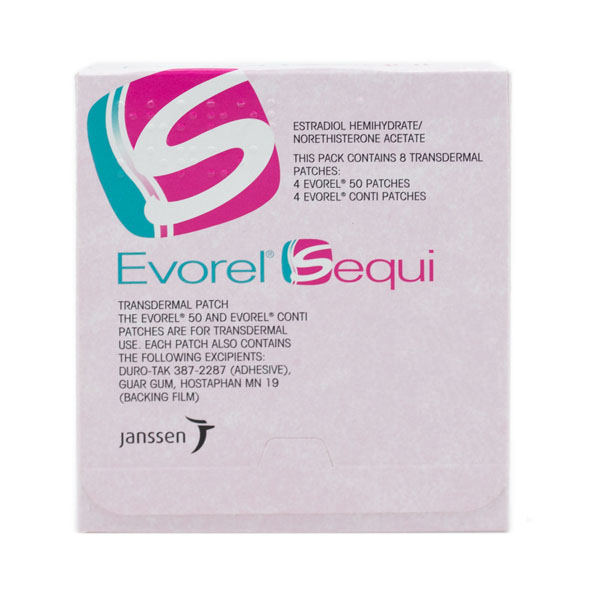Evorel Sequi Patches & Weight Loss: What the Evidence Really Says
What Evorel Sequi Is – and Isn’t
Evorel Sequi is a sequential hormone-replacement therapy (HRT) patch pack. It delivers oestrogen alone for part of the month, then oestrogen plus a progestogen for the rest. You wear one patch at a time and change it twice a week. It is designed to ease menopausal symptoms – not to change your clothing size.
You’ll see “weight gain” listed in the official leaflet as a possible side effect. That is a labelling requirement, not a promise. It means some users in trials reported it. It does not prove the patch causes fat gain in everyone. Honestly, labelling language can sound scarier than the data.

Does HRT Cause Weight Gain?
Short answer – not really. NHS guidance says there’s little evidence that most forms of HRT make you put on weight. Women often gain weight during the menopausal years whether they take HRT or not. Ageing, sleep disruption, and activity changes do a lot of the lifting here.
Women’s Health Concern and the British Menopause Society echo this. They note frequent midlife weight gain and central fat shift, but no strong evidence that HRT itself is the driver. Some types may cause short-term bloating or fluid retention, which can nudge the scales without adding fat.
Why Weight Changes Around Menopause
Oestrogen falls. Activity often dips. Lean muscle drops and resting metabolism slows. Fat moves towards the middle. That mix explains the stubborn waistband more than any single prescription. Observational and clinical reviews point to ~0.7–1.5 kg per year on average through the transition, with more visceral fat. It’s uncomfortable to hear, but it’s normal biology.
Could HRT Slow Weight Gain?
Possibly – but don’t bank on it. Some research suggests oestrogen therapy may blunt the shift towards central fat and help body-composition trends, though evidence is mixed and not high-quality. Transdermal vs oral differences remain uncertain. Translation: HRT can support symptom control, sleep, and activity; those may help your weight indirectly. It is not a slimming therapy.
What the Label Actually Says About Weight
“Weight gain” appears as a common side effect for Evorel Sequi and related patches in UK product information. Common usually means between 1 in 10 and 1 in 100 users. It sits alongside things like breast tenderness, skin irritation, water retention, headache, and mood changes. Worth knowing, not worth panicking about.
If Your Weight Goes up on Evorel Sequi
First, separate fat gain from fluid shifts. HRT – like many medicines – can cause temporary fluid retention. That can add a kilo or two in days. Waist measurements and how clothes fit are often more honest than a random Tuesday weigh-in. If concerns persist beyond the settling-in period (usually three months), speak with your prescriber; dose or regimen can be tweaked.
Practical checks:
- Track waist and weekly average weight, not single days.
- Note timing of patch changes and any bloating.
- Log sleep, steps, and hot-flush relief — they influence appetite and movement.
When to call the clinic:
- Ongoing swelling, rapid weight change, or mood effects that don’t settle.
- New bleeding patterns outside what’s expected on sequential HRT.
- Any red-flag symptoms your leaflet lists (leg swelling, chest pain, severe headache).
Honest Advice on Managing Weight While Using HRT
HRT can make life livable – better sleep, fewer flushes, clearer head. That makes diet and movement easier to stick to. The basics still win.
Keep it simple:
- Aim for protein at each meal and two fists of veg daily.
- Walk most days; add two short strength sessions per week.
- Guard sleep – it moderates hunger.
- Alcohol and ultra-processed snacks? Fewer is better.
Smart expectations:
- Expect small losses – 0.25 – 0.5 kg per week tops.
- Plateaus happen. Hold the line for two weeks before changing anything.
- If life is heavy, maintenance is a win. “Not gaining” is progress during chaos.

My Take – Blunt, but Fair
Evorel Sequi is good HRT for the right person. It’s not a weight-loss patch. If you lose weight while using it, it’s because you’ve changed behaviour, sleep, or stress – or because symptoms eased and you can move again. If you gain, check food, steps, and fluid first. Blaming the patch alone is tidy; reality is messier.
If weight is your main worry, be open about that with your clinician. Sequential patches, continuous patches, gels, intrauterine progestogen – there are options. The goal is symptom control with a side-effect profile you can live with. Use medicines for what they’re licensed to do. Use lifestyle for the rest.
